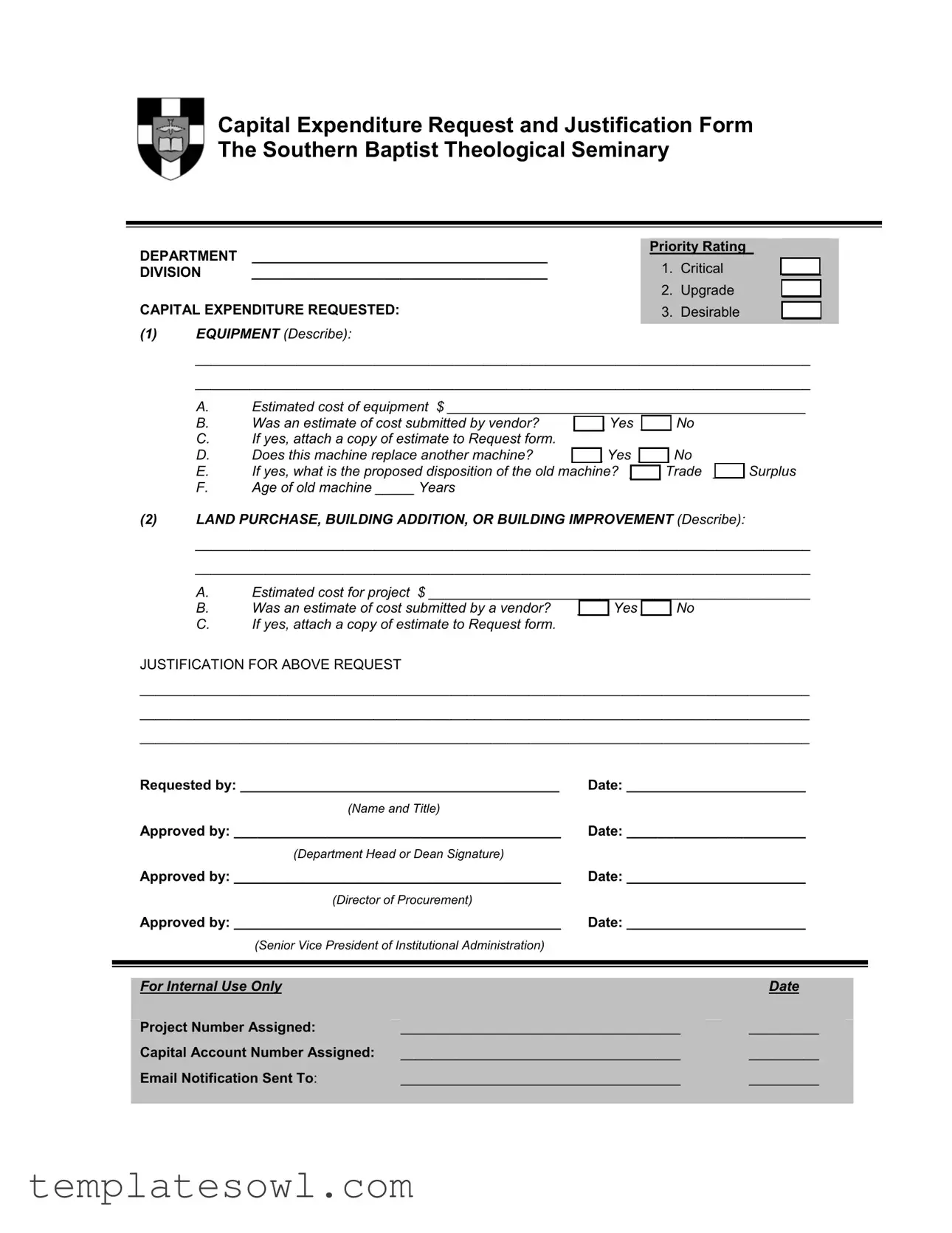CapiTal Expenditure Request and Justification Form The Southern Baptist Theological Seminary
DEPARTMENT |
______________________________________ |
|
Priority Rating_ |
|
|
1. |
Critical |
|
DIVISION |
______________________________________ |
|
|
|
2. |
Upgrade |
|
|
|
|
|
CAPITAL EXPENDITURE REQUESTED: |
|
3. |
Desirable |
|
|
|
|
|
|
|
(1)EQUIPMENT (Describe):
_______________________________________________________________________________
_______________________________________________________________________________
A.Estimated cost of equipment $ ______________________________________________
B. |
Was an estimate of cost submitted by vendor? |
____ |
Yes |
____ |
No |
C.If yes, attach a copy of estimate to Request form.
|
|
|
|
|
|
|
|
|
|
|
D. |
Does this machine replace another machine? |
____ |
|
Yes |
____ |
No |
|
|
E. |
If yes, what is the proposed disposition of the old machine? |
____ |
Trade |
____ |
Surplus |
F.Age of old machine _____ Years
(2)LAND PURCHASE, BUILDING ADDITION, OR BUILDING IMPROVEMENT (Describe):
_______________________________________________________________________________
_______________________________________________________________________________
A.Estimated cost for project $ _________________________________________________
B. |
Was an estimate of cost submitted by a vendor? |
____ |
|
Yes |
____ |
No |
C.If yes, attach a copy of estimate to Request form.
JUSTIFICATION FOR ABOVE REQUEST
______________________________________________________________________________________
______________________________________________________________________________________
______________________________________________________________________________________
|
|
Requested by: _________________________________________ |
Date: _______________________ |
|
|
|
|
|
(Name and Title) |
|
|
|
|
|
|
|
Approved by: __________________________________________ |
Date: _______________________ |
|
|
|
|
(Department Head or Dean Signature) |
|
|
|
|
|
|
|
Approved by: __________________________________________ |
Date: _______________________ |
|
|
|
|
|
(Director of Procurement) |
|
|
|
|
|
|
|
Approved by: __________________________________________ |
Date: _______________________ |
|
|
|
(Senior Vice President of Institutional Administration) |
|
|
|
|
|
|
|
|
|
|
|
|
|
|
|
|
|
|
|
|
|
|
|
|
|
|
|
|
|
|
|
|
|
|
|
|
|
|
|
|
|
|
|
For Internal Use Only |
|
|
|
|
|
|
Date |
|
|
|
|
Project Number Assigned: |
|
____________________________________ |
|
_________ |
|
|
|
|
|
|
|
|
|
|
|
|
|
|
|
|
|
|
|
|
|
|
Capital Account Number Assigned: |
|
____________________________________ |
|
_________ |
|
|
|
|
Email Notification Sent To: |
|
|
____________________________________ |
|
_________ |
|
|
|
|
|
|
|
|
|
|
|
|
|
|
Instructions: Capital Expenditure Request and
Justification Form
DEPARTMENT |
Name of the specific department making the request. |
DIVISION |
Name of department’s organizational location: |
|
Academic Administration |
|
Institutional Administration |
|
Institutional Relations |
IMPORTANT! |
Budget Managers are expected to anticipate needs for their departments prior to the |
|
annual budget approval process. Future capital needs should be planned for and |
|
incorporated during the annual budget request. |
|
|
PRIORITY 1: |
CRITICAL – Required to prevent a critical reduction in service, operating efficiency, |
|
economy, and/or safety; to protect valuable property; and/or comply with insurance |
|
or code requirements. |
PRIORITY 2: |
UPGRADE – Required for significant upgrade in service, operating efficiency, |
|
economy and/or safety of current operations. |
PRIORITY 3: |
DESIRABLE – Required to introduce desirable, but optional new service, program, |
|
faculty or staff, or to make small improvements in operating efficiency, economy |
|
and/or safety. |
|
|
“CAPITAL EXPENDITURE REQUESTED” EXPLANATION
(1)How is equipment defined?
Any item(s) not affixed to a building or land. Includes computer items, vehicles, furniture, etc.
A.Estimated cost for project
Total cost of acquiring and placing the equipment in service, including shipping, installation, consulting, training and other direct costs.
B.Was an estimate of cost submitted by a vendor?
Although helpful, quotes are not required as a part of the request for capital expenditure process. If the request is approved, the following schedule should be adhered to for securing quotes.
$2,500 or above requires three (3) quotes
$10,000+ requires the RFP process
E.What is the proposed disposition of the old machine?
If the old equipment is traded in to receive a lower price on the purchase of new equipment check "Trade" box. If not check "Surplus" box and contact Central Stores for removal.
(2)Land Purchase, Building Addition, or Major Improvement
Includes any new independent, habitable structures, additions or renovations of existing habitable structures, and furnishings and equipment which are permanently affixed to a habitable structure.
A.Estimated cost for project
Include shipping, installation, consulting and all other costs directly associated with acquiring the improvement and placing it in service.
B.Was an estimate of cost submitted by a vendor? See explanation on (1) Equipment.
Routing and approval process: Send request, signed by department budget manager, along with any
explanatory attachments to: Office of Procurement Sampey Hall, Room 4103

